Top Rankings
Norton City School District ranks among the top 20% of public school district in Ohio for:
Category
Attribute
Overall Rank
Highest overall rank (Top 20%)
Math Proficiency
Highest math proficiency (Top 20%)
Reading/Language Arts Proficiency
Highest reading/language arts proficiency (Top 20%)
Community Size
Largest student body (number of students) (Top 1%)
Student Attention
Lowest student:teacher ratio (Top 1%)
For the 2025 school year, there is 1 public preschool serving 216 students in Norton City School District.
Public Preschools in Norton City School District have a diversity score of 0.17, which is less than the Ohio public preschool average of 0.58.
Minority enrollment is 9% of the student body (majority Asian and Hispanic), which is less than the Ohio public preschool average of 39% (majority Black).
Overview
This School District
This State (OH)
# Schools
4 Schools
839 Schools
# Students
2,216 Students
334,112 Students
# Teachers
174 Teachers
18,897 Teachers
Student : Teacher Ratio
13:1
13:1
District Rank
Norton City School District, which is ranked within the top 20% of all 918 school districts in Ohio (based off of combined math and reading proficiency testing data) for the 2021-2022 school year.
The school district's graduation rate of 90-94% has decreased from 95% over five school years.
Overall District Rank
#166 out of 929 school districts
(Top 20%)
(Top 20%)
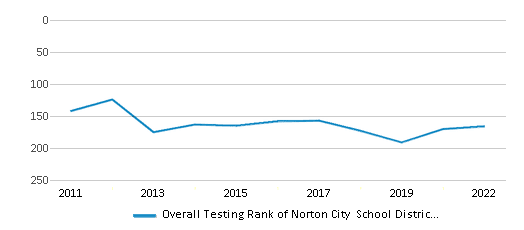
Math Test Scores (% Proficient)
71%
52%
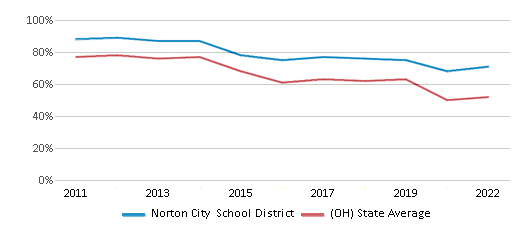
Reading/Language Arts Test Scores (% Proficient)
72%
60%
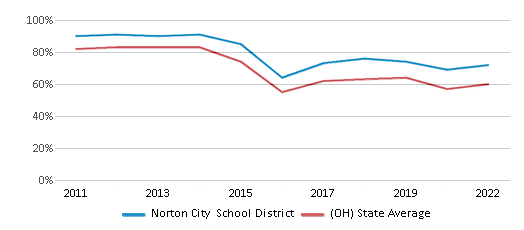
Science Test Scores (% Proficient)
71%
63%
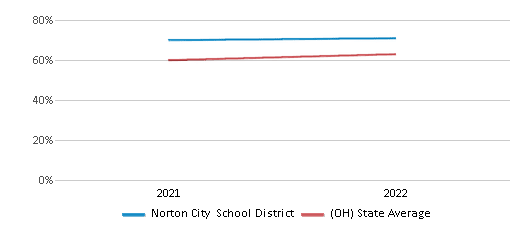
Graduation Rate
90-94%
86%
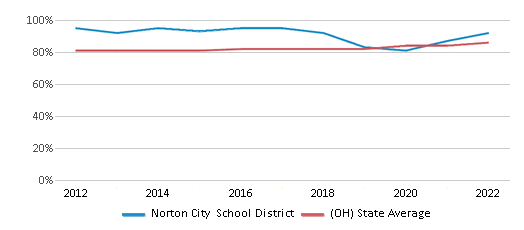
Students by Ethnicity:
Diversity Score
0.17
0.58
# American Indian Students
n/a
462 Students
% American Indian Students
n/a
n/a
# Asian Students
23 Students
8,061 Students
% Asian Students
1%
3%
# Hispanic Students
46 Students
30,384 Students
% Hispanic Students
2%
9%
# Black Students
36 Students
67,190 Students
% Black Students
2%
20%
# White Students
2,012 Students
204,949 Students
% White Students
91%
61%
# Hawaiian Students
n/a
329 Students
% Hawaiian Students
n/a
n/a
# Two or more races Students
99 Students
22,737 Students
% of Two or more races Students
4%
7%
Students by Grade:
# Students in PK Grade:
81
45,802
# Students in K Grade:
135
55,948
# Students in 1st Grade:
143
51,388
# Students in 2nd Grade:
148
49,073
# Students in 3rd Grade:
149
40,515
# Students in 4th Grade:
187
38,905
# Students in 5th Grade:
153
30,860
# Students in 6th Grade:
173
12,193
# Students in 7th Grade:
162
4,329
# Students in 8th Grade:
172
4,221
# Students in 9th Grade:
142
368
# Students in 10th Grade:
182
211
# Students in 11th Grade:
205
188
# Students in 12th Grade:
184
111
# Ungraded Students:
-
-
District Revenue and Spending
The revenue/student of $13,095 in this school district is less than the state median of $17,287. The school district revenue/student has grown by 6% over four school years.
The school district's spending/student of $12,282 is less than the state median of $17,235. The school district spending/student has grown by 6% over four school years.
Total Revenue
$29 MM
$28,879 MM
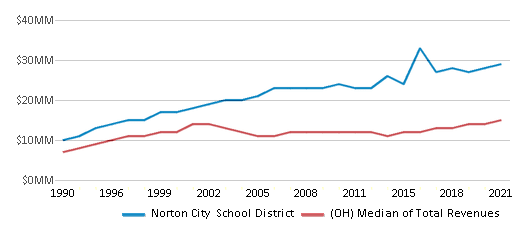
Spending
$27 MM
$28,792 MM
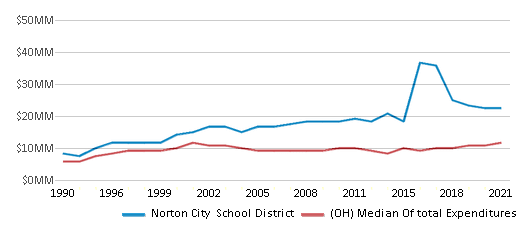
Revenue / Student
$13,095
$17,287
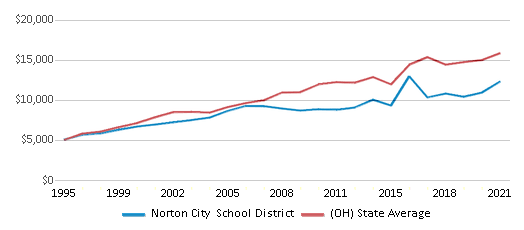
Spending / Student
$12,282
$17,235
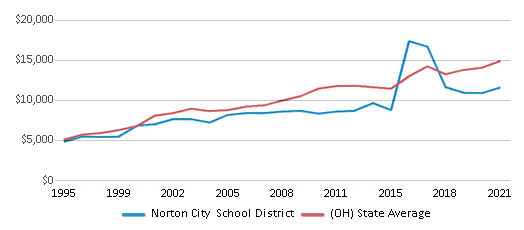
Best Norton City School District Public Preschools (2025)
School
(Math and Reading Proficiency)
(Math and Reading Proficiency)
Location
Grades
Students
Rank: #11.
Norton Primary Elementary School
(Math: 90-94% | Reading: 80-84% )
Rank:
Rank:
10/
Top 10%10
3163 Greenwich Rd
Barberton, OH 44203
(330) 825-5133
Barberton, OH 44203
(330) 825-5133
Grades: PK-K
| 216 students
Recent Articles

Year-Round Or Traditional Schedule?
Which is more appropriate for your child? A year-round attendance schedule or traditional schedule? We look at the pros and cons.

Why You Should Encourage Your Child to Join a Sports Team
Participating in team sports has a great many benefits for children, there is no doubt. In this article you will learn what those benefits are.

White Students are Now the Minority in U.S. Public Schools
Increasing birth rates among immigrant families from Asia and Central and South America, combined with lower birth rates among white families, means that for the first time in history, public school students in the United States are majority-minority. This shift in demographics poses difficulties for schools as they work to accommodate children of varying language abilities and socio-economic backgrounds.





